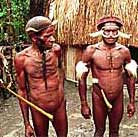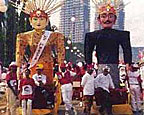|
|
Traveller Tips |
Get in (Visa information)
| Dos and Don'ts |
Culture and Holiday |
Destinations
| Destination |
The National Monument
The National Monument, or "Monas" as it is
popularly called, is one of the monuments
built during the Sukarno era of fierce
nationalism. It stands for the people's
determination to achieve freedom and the
crowning of their efforts in the Proclamation
of Independence in August 1945. The 137-metre
tall marble obelisk is topped with a flame
coated with 35 kgs. of gold. The base houses a
historical museum and a hall for meditations.
The monument is open to the public and upon
request the lift can carry visitors to the top
which offers a bird's eye view on the city and
the sea.
|
Parliament Building
This strikingly modern building on Jalan Gatot
Subroto is the parliament where at least once
in every five years, the People's Consultative
Assembly (the National Congress) holds its
sessions. When not in session, visitors are
allowed in but permission must be obtained in
advance. |
Satria Mandala Museum
This central museum of the Armed Forces
displays exhibits on the progress in the
development of the Indonesian Armed Forces,
its role in the struggle for the nation's
independence, and other military relics. Open
daily except Mondays. |
Orchid Gardens
Same of the most exotic orchids come from
Indonesia. Several commercial orchid gardens
are open to the public, the best known of them
is located at Slipi and Taman Mini. |
Condet
This village in southern Jakarta is a
protected area where the old rural life style
of Jakarta is preserved. Condet is also famed
for its fruit archards.
|
Ragunan Zoo
Jakarta's zoo is situated in the suburb of
Ragunan in the southern part of the city. Laid
out in a lush tropical setting, such
indigenous animals as the Komodo lizard,
tapir, anoa, Java tiger, banteng wild ox and
brightly coloured birds are given ample room
to fly freely in the green foliage.
Open daily from 8.00 a.m. to 6.00 p.m. The
zoological garden is most crowded on Sunday
and public holidays.
|
Central Museum
Established in 1778 by U.M.C. Rademacher under
the auspices of the Batavia Association of
Arts and Sciences, it offers historical,
prehistorical, archaeological and ethnographic
aspects of Indonesia through its extensive
collection of artifacts and relics which date
as far back as to the Stone Age. It has one of
the most complete collections of bronzes and
ceramics dating back to the Han, Tang and Ming
Dynasties. The Museum has one of the finest
numismatic collections in the world, including
cloth and money which was used on several
islands until recently. The religious art
section is filled with statuary and sculpture
salvaged from sites of Hindu, Buddhist and
Islamic edifices. Its collection of cultural
instruments, household utensils, arts and
crafts provide an introduction to the life of
the various ethnic groups which populate
Indonesia. This museum is popularly known as
Gedung Gajah or "Elephant Building" because of
the stone elephant offered by King
Chulalongkorn of Thailand in 1871, placed on
the pront lawn of the building. |
Indonesia in Miniature Park
An extensive park to get a glimpse of the
diverseness of the Indonesian archipelago, it
represents Indonesia's 27 provinces and their
outstanding characteristics, reflected most
strikingly in the exact regional architecture
of the province. It has its own orchid garden
in which hundreds of Indonesian orchid
varieties are grown. There is also a bird park
with a walk-in aviary, a fauna museum and
recreational grounds with a swimming pool and
restaurants.Of special interest here at Taman
Mini is the Museum Indonesia. A richly
decorated building in Balinese architecture,
it houses contemporary arts crafts and
traditional costumes from the different
regions of the country. Open from 9.00 a.m. to
4.00 p.m. daily.
|
|



 |
|
| |
|